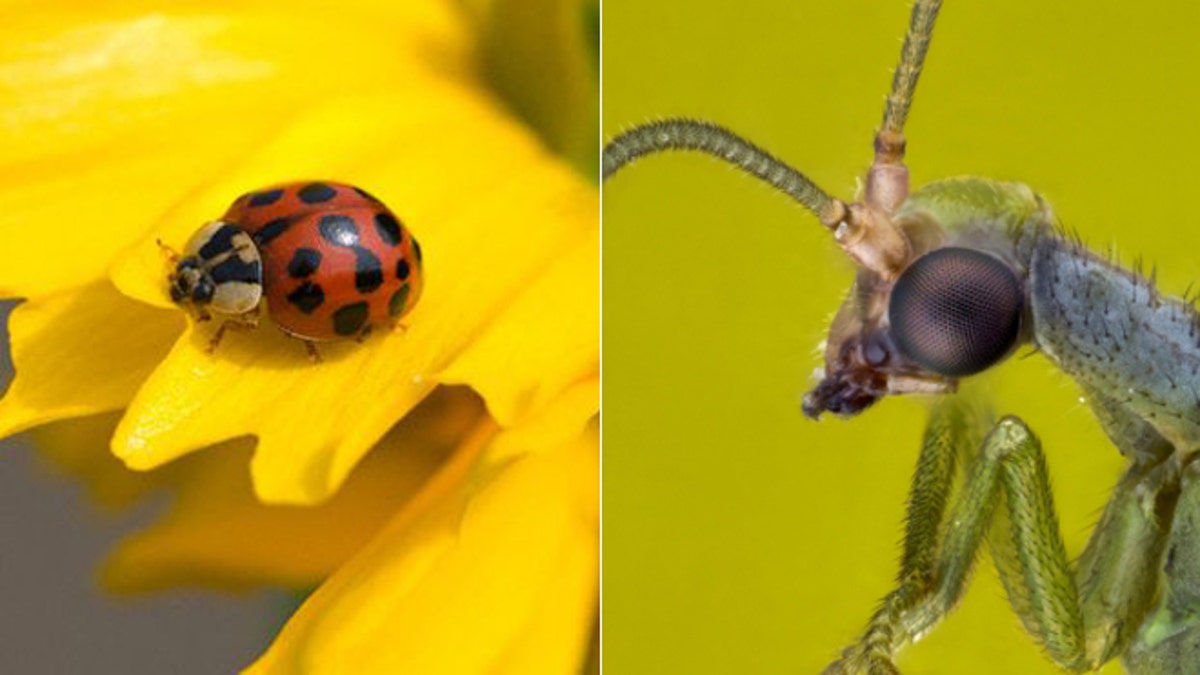
Ladybug and Green Lacewing
It’s an all-too-common story for many gardeners — a thriving springtime garden seems to suddenly stall. Wilted plants and decimated leaves offer up their telltale signs: the pests have arrived.
The culprits should be familiar to any seasoned green thumb. An army of tiny invaders — caterpillars, mites, slugs and beetles — have cut down your garden before it ever really had a chance.
Beneath the foliage and budding strawberries, there lurks a war, one being fought by tiny insect soldiers. Some of these, like aphids and mealybugs, are hard at work destroying your garden. Others, however, have set their sights on the invaders themselves, dining down on these noxious pests. Here are the five best insects for your garden and some tips on how to encourage them to take up residence in your yard.
Ladybugs
Voracious aphid eaters, ladybugs are probably the helper insect you’re most familiar with. Bright red and polka-dotted, these beetles can tear through a colony of aphids in no time. And it’s not just the elder bugs that eat pests; the ladybug’s larvae can devour 100 aphids an hour, and will also help control a host of other problem bugs, like spider mites and scale insects. While you can plant a number of things to help attract ladybugs, including dill, angelica and cilantro, the best way to get a thriving colony of these red-domed insects in your garden is to buy some. Most garden stores will sell lady bugs, or you can even buy them online, making them an affordable, natural pesticide for your garden.
Green Lacewings
With their large translucent wings and bright green body, it’s easy to identify the green lacewing in you garden. While the adult lacewings often prefer nectar and pollen, lacewing larva love aphids and are a great way to control problem pests. Because they don’t tend to get along with one another in their adult stage, lacewings are sold as eggs, which you can add to your garden to keep bad bugs in check.
Nematodes
Almost impossible to see with the naked eye, these colorless roundworms are extremely effective at knocking out pests below the soil, an area that is often tough to treat with traditional pesticides. These tiny worms work their way into grubs, beetles and weevils, killing them with a parasitic bacteria in a matter of days. Not all nematodes are created equal, of course. Some species will actually attack plant roots and others can cause disease in humans. From a pest control perspective, you’ll want to stick with a species that strictly takes down nasty insects, but doesn’t cause any problems in animals or plants.
Honeybees
While they don’t dine on aphids or mites, bees still play a central roll in growing a healthy garden. A buzzing swarm of bees will ensure that your garden is properly pollinated. If you’d like to help the process along, you can purchase and set up a honeybee hive on your property, which will both improve plant growth and give you a steady supply of honey. If caring for a bee colony is a little too much work for you, you can also rent a hive. A beekeeping professional will come to your place to set up the hive and help you care for it through the season, giving your garden the boost it needs.
Praying Mantis
A beautiful and graceful bug, the praying mantis is also deadly to most insects, many of which do damage to your garden. These voracious predators take out more than just aphids and mites, though. Because they eat just about any insect they can get their arched arms on, they can also help you tackle infestations of mosquitoes, houseflies and moths. And best of all, you can pick up a case of them at Costco for less than $20.